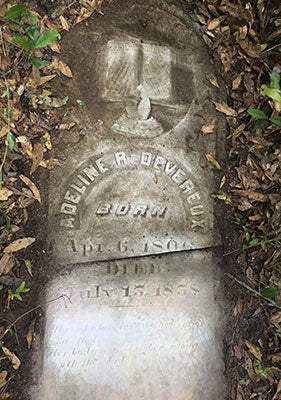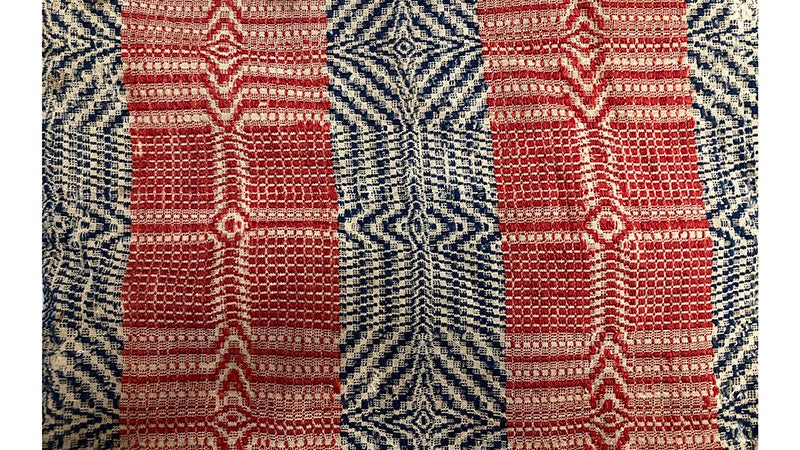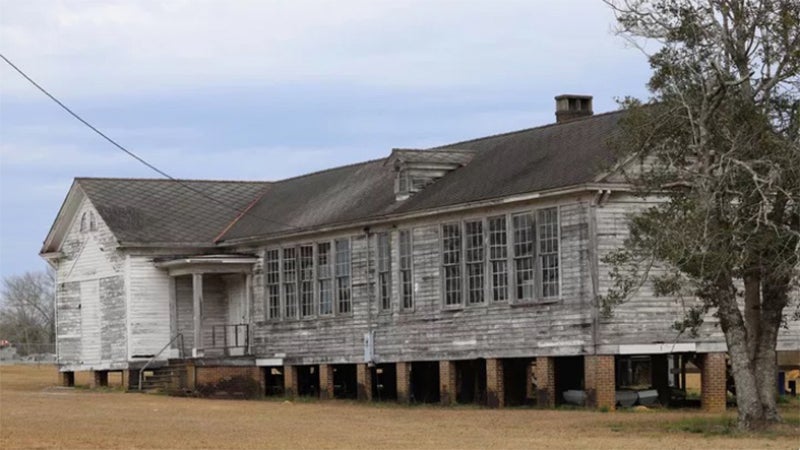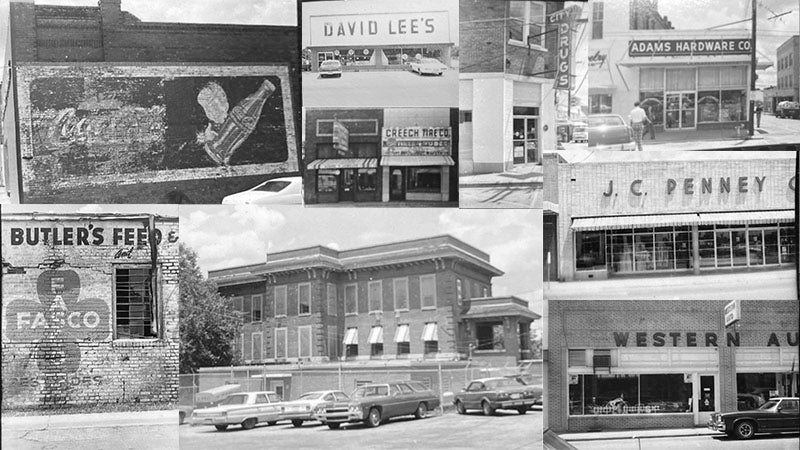Remember When: Bradley Cemetery is 170 years old
Published 2:15 am Saturday, April 20, 2019

- Grave stone in Bradley Cemetery. Courtesy Photo
“Where Have All the Flowers Gone” I was singing to myself as we walked down that path then stepped into a thick wooded area off Swamp Road (dirt) that turns off County Road 7 in the Loango community of Covington County. What is known by some as the historic Bradley Cemetery appears today as an unnoticeable place on leased hunting land. A few old tombstones are still in place with only illegible markings of “MB” there on the moldy markers.
A visitor to my office beckoned me to accompany him to this cemetery where early Covington County history lies abandoned and forgotten for the most part. Mr. Roy Lord, a nearby neighbor, was excited to have some lover of local history to be interested in identifying and preserving the site. As a young teenager, he had known about the cemetery back when some headstones were still in place. He cannot say for sure how big an area the cemetery used to encompass, but he can say for certain that he now has an appreciation for its importance and preservation.
Lord attended and was graduated from Red Level School in the mid-1960s. He has lived most of his life in the area on his father’s homestead with the exception of serving in Vietnam and working off and on at various out-of-town jobs. He knows the significance of the Bradley Plantation and the John William Devereux connection to Covington. His interest and concern for this haven of rest is admirable as is his earnest desire to clear the weeds, scrub oaks, moss, and rubbish from the cemetery thicket once held sacred to the memory of those resting souls.
So on this beautiful late spring afternoon, my husband Jimmy and I headed to Loango to meet up with Mr. Lord. We followed him up the road apiece, turned on Swamp Road, and then parked where we walked a short piece down a path to what I thought would be a clearing but not so! The two men sort of blazed a trail through thick woods, and “Sue City Sue” was right behind them. We walked on thick beds of leaves in between vine-covered branches. We were hoping that low soft spots were not sunken graves that had settled through approximately 170 years, the date of the one readable tombstone we viewed.
Broken in half and fallen on the ground, the headstone was carefully wire-brushed. Chalk was then applied (as genealogists routinely do) to discover the name, dates, and epitaph on the grave of “Adeline R. Devereux, BORN April 6, 1806, DIED July 15, 1858.” Carved artwork at the top of the rounded stone appeared to be an open book that we soon cleared debris and dirt from to reveal a right wrist and hand with thumb holding the Holy Bible.
Almost missed below the dates was an epitaph of penmanship typical of the times that we worked on for a while to finally uncover these words, “Here she lies, left us her spirit, her mark. Her body now slumbers along with the dead.” If that is not it exactly, it is close to it!
My thoughts were swirling – Devereux Hill, John William Devereux, the “father of Covington County,” the Bradley Plantation! We are standing in the midst of ground the early settlers of Covington County and pioneers once farmed and built log cabins on. And yes, there were slaves who came with them who worked the Bradley Plantation. Many descendants now carry the Bradley name. History cannot be refuted. We can only learn from it. That is one reason the study of history is important.
Upon returning to my home library, I pulled out the books of Wyley Ward, our local historian who has carefully detailed the history of the county through years of research in “Early History of Covington County, 1821-1871.” Along with some of his other booklets, I knew I would come across information on Adeline R. Devereux whose middle name turned out to be Rebeccah.
Heaven help me if I don’t quote Wyley Ward correctly! This will strictly be a summary of many details I read about in Ward’s books that he has so thoroughly researched in his years of study. John Devereux was the oldest son of Charles and Nancy (Woods) Devereux. Born in Virginia, John worked on his father’s plantation beginning at age 16, but he did not like the work as overseer of slaves so he left home and went to Georgia. He worked as a clerk and borrowed enough money to start his own mercantile business until the Indians went on the warpath in the early 1790s at which time his business failed.
In 1792, he joined a cavalry company in the U. S. Army and served in that capacity for three years. He married Elizabeth Few in 1795, but she died in childbirth in 1799. Still in Georgia, he once more went back into the merchandising business and married for a second time in 1801 to Sally Griggs who bore him four children. In 1810, Sally died in childbirth. In addition to merchandising, he became interested and involved in politics in Georgia serving as a justice of the peace, a term in the state legislature, and a member on a number of commissions.
In 1817, John Devereux moved with his two young sons, Albert and Julien and 10 slaves into the Alabama territory settling first in Conecuh County near the Sepulga River. He left his daughter Louisiana in Georgia with his brother. A second daughter had died at the age of one. While at this location, his son Albert had visited Pensacola, contracted Yellow Fever, and died in 1822.
Living in Conecuh County, Devereux served as a justice of the peace and as a state senator representing several counties including Covington. He introduced the bill to divide Henry County and create new counties. It is not known if he helped select the names of Covington and Pike counties, but he certainly would have had input. Both counties were named for war heroes, brigadier generals in the U. S. Army, who were killed in the War of 1812.
Devereux and his son Julien moved to Covington County in 1823 probably after the first public land sales were held at Sparta. John was still serving in the State Senate so he was certainly consulted with the selection of organizing county commissioners. John was appointed by the governor as Covington County Court Judge in 1824 to replace Stone who resigned which is probably the primary reason for Devereux’s moving to Covington. With his state legislative background, close connection to the governor, and chairman of the county revenue and roads commission, he quickly gained control of Covington County’s politics that he retained control of for the next seven years. He became a dominant political figure.
In 1824 Julien purchased 80 acres of land near the site selected for the county courthouse in the Montezuma settlement at the falls of the Conecuh River and established a plantation which he called “The Heritage.” He eventually owned 240 acres adjoining the east side of the village at the foot of what we now refer to as “Debro Hill.”
John Devereux next made application to become postmaster at the Covington County Courthouse. Soon after he was appointed county court judge. It is very possible that he called the place “Montezuma” since the earliest postal record in 1825 was found using that name previously listed and known as “Covington C.H.” Wyley Ward stated that he was known for naming places. Another local historian Sidney Waits wrote that the “mystery of the naming of the Montezuma village has never been completely unraveled.”
In the next few years, much wrangling went on in county politics which included the imposing of taxes for construction of a courthouse and a jail along with efforts to purchase land to build these buildings. After a few years, John’s political strength was eroded in the state and local levels. However, his son Julien was elected as a State Representative for Covington and Conecuh in 1832 probably winning enough extra votes in Conecuh County to win the election. Although John Devereux became disliked by the land owners at Montezuma, he was still respected by the Covington County voters.
In 1826 Julien had been appointed to fill the vacancy for Circuit Clerk of Covington. At the age of twenty-one, Julien became one of the most eligible bachelors, and then married Adeline Rebecca Bradley on December 18, 1826, daughter of Samuel and Mary Bradley, one of the wealthiest families in the county. This along with his father’s political connections quickly established him as one of the most promising young men in Alabama.
It did not take long for Julien to tap into the Bradley money after his marriage. In 1828 Julien was appointed a justice of the peace and an 1830 a U. S. Census Taker. In 1830 Mary Bradley, Julien’s mother-in-law, died leaving her two surviving daughters as heirs. Julien was appointed administrator of her estate. All of these political aspirations detracted from Julien’s duties on the farm. He continued to purchase more and more land, some on credit, and to neglect his farming operations. His creditors began closing in on him.
The Bradley money along with the political problems his father was having in Covington County probably prompted Julien to begin looking for a larger and more fertile plantation so in 1834 Julien purchased land in the newly formed Macon County and moved there with his wife Adeline and most of their slaves. John resigned as postmaster at Montezuma, followed his son, and opened a post office at his property he named “Valverdi.” In 1836 John was elected State Senator for Macon County where he served for three years until his political career ended in 1839.
Although Julien retained ownership of his Covington County property, he once again removed this time to Texas. His father John soon followed. In addition to his financial problems, Julien had more serious problems when he fathered two children in an affair in 1839 at which time Adeline separated from him and returned to her relatives in Covington and Conecuh Counties.
To make things worse, when Julien sold his Macon County plantation and ran off to Texas with most of Adeline’s slaves, he also took the money from Mary Bradley’s estate or the portion that should have been Adeline’s, and most of their possessions. Lawsuits ensued and Adeline sought relief from the Alabama legislature who alleged she had been abandoned by her husband leaving a considerable amount of indebtedness behind. Julien filed a petition for divorce from his wife charging her with having an ill temper, uncontrolled excesses of passion, and outrageous conduct along with other unmentionables. (Wonder why?)
Adeline was not represented at the trial, and Julien was granted a divorce. It is certain that no mention was made of Julien having illegitimate children or of the facts that Adeline’s mother died five weeks before her child was born, and that her only brother died two weeks after the child’s birth.
In 1843, Julien married a third time to a sixteen year old from a prominent Texas family at which time he settled down and purchased and developed a large plantation ranch which was given the name “Monte Verdi.”
Neither Julien nor his father John Devereux ever returned to Alabama, and no evidence has been found to indicate that they ever made direct contact with Adeline after moving to Texas. Some of Julien’s closest associates in Alabama wrote in a letter, “Julien Devereux is the damnest raskel now living on the face of the earth.”
In a letter to Julius Robinson dated 1844, Norborne B. Powell of Macon County, a neighbor to Julien, wrote, “I am very sensible that Mrs. Devereux has been shamefully treated by that craven heated reckless man—and if he has not lost all sense of shame and has not extinguished all moral faculty that presides in the bosom, he must ever feel the rankling thorn, yea, the morn that man dies, the day of retribution justice stares him in the face, more terrible than the lightning strike.”
John Devereux died in 1847 at age of 79 years after keeping a diary in his old age for seven years on his experiences in life. After John’s death, Julien wrote in the blank pages at the end of his father’s diary, “He departed this life on that day at the going down of the sun surrounded by the family and his friends and neighbors at peace with his creator and all the world.”
Adeline continued living with or near her niece whom she had reared and husband, Julius and Margaret Bradley Robinson, until her death on July 15, 1858. She was buried in the Bradley Cemetery located in the Loango community along with her grandmother, Margaret Matilda Bradley, and uncle, Matthew Bradley, Jr. (Maybe those letters we saw on the weathered tombstones in the cemetery “M.B.” were for Margaret and Matthew! Maybe a stone cutter was not available at the time on the Alabama frontier.)
Julius Robinson, husband of Margaret Bradley, by the way, was a well-educated merchant and postmaster at Brooklyn in Conecuh County. He was appointed executor of Adeline’s estate.
Julien died in 1856. Both John and Julien are buried near the extensive “Monte Verdi” plantation in Rusk County, Texas now an historic tourist site. Julien’s young widow maintained her household and his plantation until after the Civil War. A book titled, “Julien Sidney Devereux and his Monte Verdi Plantation” (1962) was written by Dr. Dorman H. Winfrey. The diary of John Devereux can be found at the University of Texas and in the Montgomery County, Texas Library. Wyley Ward writes, “The actions of John William Devereux and his son Julien while living in Covington County (for some 12 years – 1823-1835) leave something to be desired, but no one can argue about the contributions made by John Devereux in the development of the county. He left two images – one of a ruthless politician; the other was of a compassionate man who would support his friends in any endeavor. It was men like him that set and guided the course for the early developments in the U. S. He left his marks in Georgia, Alabama, and Texas. ‘Debro Hill’ is named in his honor.”
Remember When a story uncovered like this, a tale from the tomb, of a significant grave of a Devereux family member helped preserve some valuable history of Covington County. By the way, it is suspected that Loango may not have been named for “Load ‘n go,” but from a state in Africa called Loango! The Bradley plantation workers just may have had a significant input into the naming of their home!
Sue Bass Wilson, AHS Class of 1965, is a local real estate broker and long-time member of the Covington Historical Society. She can be reached at suebwilson47@gmail.com.





